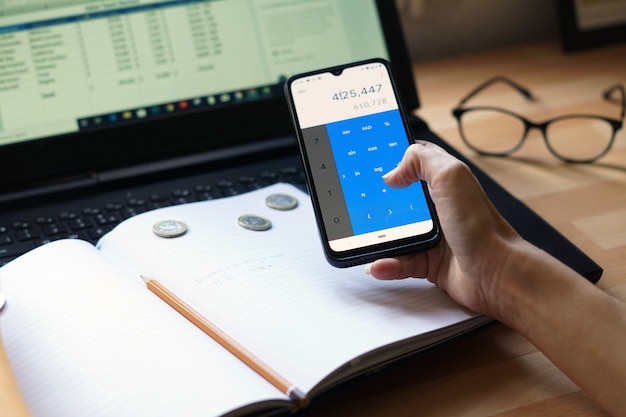Reduce Debt by 15% This Year: 3 Essential Finance Tips

Reduce debt by 15% this year by adopting three key personal finance strategies: creating a detailed budget, prioritizing high-interest debt repayment, and automating savings and debt payments.
Are you aiming to significantly reduce your debt this year? Achieving financial freedom requires a strategic approach. This article provides 3 Personal Finance Tips to Reduce Debt by 15% This Year, offering practical steps to regain control of your finances and accelerate your journey to being debt-free.
Create a Budget and Track Your Spending
Creating a budget is the cornerstone of any effective debt reduction strategy. A well-defined budget provides a clear picture of your income and expenses, allowing you to identify areas where you can cut back and allocate more funds towards debt repayment.
Tracking your spending is equally important. It helps you stay accountable to your budget and identify potential overspending habits that can derail your progress. Let’s explore how to create a budget and track your spending effectively.
Establish Your Income
Begin by calculating your total monthly income. This includes your salary, wages, any side hustle income, and other sources of revenue. Be as accurate as possible to get a realistic view of your financial inflow.
List Your Expenses
Next, list all your monthly expenses. Divide them into fixed expenses like rent, mortgage payments, and insurance, and variable expenses such as groceries, entertainment, and transportation. Use bank statements, credit card bills, and receipts to track every expense.

Categorize Your Expenses
Organize your expenses into categories to identify spending patterns. Common categories include housing, transportation, food, entertainment, and debt payments. This categorization helps you see where your money is going and where you can make adjustments.
- Use budgeting apps: Numerous apps like Mint, YNAB (You Need a Budget), and Personal Capital can automate expense tracking and provide insights into your spending habits.
- Review regularly: Make it a habit to review your budget and spending at least once a week. This helps you stay on track and make necessary adjustments.
- Set realistic goals: Avoid setting overly restrictive budgets that are difficult to maintain. Start with small, achievable goals and gradually adjust as you make progress.
By creating a detailed budget and diligently tracking your expenses, you gain valuable insights into your financial habits. This knowledge empowers you to make informed decisions, cut unnecessary spending, and allocate more funds towards debt repayment, setting you on the path to reducing your debt by 15% this year.
Prioritize High-Interest Debt Repayment
High-interest debt, such as credit card balances and payday loans, can quickly accumulate due to escalating interest charges. Prioritizing the repayment of these debts is crucial for minimizing your overall debt burden and achieving your financial goals.
Two popular strategies for prioritizing debt repayment are the debt avalanche and the debt snowball methods. Each offers a unique approach to tackling debt, and understanding their pros and cons can help you choose the one that best suits your financial situation and personal preferences.
Debt Avalanche Method
The debt avalanche method focuses on paying off debts with the highest interest rates first. By targeting these debts, you minimize the amount of interest you pay over time, leading to faster debt reduction and significant savings.
Debt Snowball Method
The debt snowball method involves paying off the smallest debt balances first, regardless of interest rates. This approach provides quick wins and psychological motivation, helping you stay committed to your debt repayment plan.
- List all debts: Start by listing all your debts, including the outstanding balance, interest rate, and minimum payment for each.
- Calculate interest savings: Use online calculators to estimate the potential interest savings of using the debt avalanche method versus the debt snowball method.
- Stay consistent: Regardless of the method you choose, consistency is key. Make regular payments and avoid taking on new debt to stay on track with your debt reduction goals.
Prioritizing high-interest debt repayment is a strategic move that can significantly accelerate your debt reduction efforts. By focusing on the debts that cost you the most in interest, you free up more funds for other financial goals and move closer to achieving financial freedom. Whether you choose the debt avalanche or the debt snowball method, consistency and discipline are essential for success.
Automate Savings and Debt Payments
Automating your savings and debt payments is a powerful way to ensure consistency and avoid missed payments. Automation simplifies your financial management, reduces the risk of late fees, and helps you build savings effortlessly.
Setting up automated transfers from your checking account to your savings and debt accounts ensures that you consistently allocate funds towards your financial goals. This strategy is particularly effective for reducing debt because it removes the temptation to spend the money elsewhere and ensures that payments are made on time.

Set Up Direct Deposit
Arrange for a portion of your paycheck to be automatically deposited into your savings account. This makes saving effortless and ensures that you consistently contribute to your savings goals.
Schedule Recurring Transfers
Set up recurring transfers from your checking account to your debt accounts. Ensure that the transfers are scheduled a few days before the payment due dates to avoid late fees.
Use Online Banking Tools
Take advantage of the online banking tools offered by your financial institution. These tools allow you to easily set up and manage automated transfers, track your progress, and receive alerts for upcoming payments.
- Review regularly: Periodically review your automated transfers to ensure they align with your financial goals and adjust them as needed.
- Start small: If you’re new to automation, start with small amounts and gradually increase them as you become more comfortable.
- Monitor your accounts: Keep an eye on your checking account balance to ensure you have sufficient funds to cover the automated transfers.
Automating your savings and debt payments is a smart financial move that can significantly impact your debt reduction efforts. By simplifying your financial management and ensuring consistency, you create a system that works for you, helping you achieve your financial goals with less effort and stress. This strategy is essential for reducing debt by 15% this year and building a more secure financial future.
Negotiate Lower Interest Rates
Negotiating lower interest rates on your debts can lead to significant savings and accelerate your debt reduction progress. Lower interest rates mean more of your payment goes towards the principal balance, allowing you to pay off your debt faster.
Contacting your creditors and negotiating for lower rates may seem daunting, but it can yield substantial benefits. Many credit card companies and lenders are willing to work with you, especially if you have a good payment history. Here’s how to approach the negotiation process effectively.
Contact Your Creditors
Reach out to your credit card companies and lenders to inquire about the possibility of lowering your interest rates. Be polite and explain your situation, emphasizing your commitment to paying off your debt.
Highlight Your Payment History
If you have a good payment history, highlight this during your negotiation. Creditors are more likely to lower rates for customers who have consistently made on-time payments.
Consider Balance Transfers
Explore the option of transferring your high-interest debt to a credit card with a lower interest rate or a promotional 0% APR offer. This can provide temporary relief and help you pay down your debt more quickly.
Negotiating lower interest rates is a proactive step you can take to reduce your debt burden and save money over time. Don’t hesitate to reach out to your creditors and explore your options. By lowering your interest rates, you can accelerate your debt repayment and achieve your financial goals faster.
Increase Your Income
Increasing your income can provide you with more funds to allocate towards debt repayment, accelerating your progress and helping you achieve your financial goals faster. A higher income not only allows you to pay off debt more quickly but also provides a financial cushion for unexpected expenses and future investments.
There are various ways to increase your income, from taking on a side hustle to negotiating a raise at your current job. Exploring these options can open up new opportunities and provide you with the financial resources you need to tackle your debt effectively.
Take on a Side Hustle
Consider starting a side hustle to supplement your income. Options include freelancing, driving for a ride-sharing service, or selling products online. Choose a side hustle that aligns with your skills and interests.
Negotiate a Raise
If you’ve been performing well at your job, consider negotiating a raise. Research industry salary standards and prepare a strong case highlighting your contributions to the company.
Sell Unused Items
Declutter your home and sell unused items online or at a local consignment shop. This can provide a quick influx of cash to put towards debt repayment.
- Invest in skills: Consider taking courses or workshops to enhance your skills and increase your earning potential.
- Network: Build connections with professionals in your industry to uncover new job opportunities or freelance projects.
- Track your progress: Monitor your income and debt repayment progress regularly to stay motivated and make necessary adjustments to your plan.
Increasing your income is a powerful strategy for accelerating your debt reduction efforts. By exploring various options and finding ways to generate more income, you can free up more funds for debt repayment and achieve your financial goals faster. Whether you take on a side hustle, negotiate a raise, or sell unused items, increasing your income is a key step towards financial freedom.
Consolidate Your Debt
Debt consolidation involves combining multiple debts into a single loan or credit card with a lower interest rate. This strategy can simplify your debt management, reduce your monthly payments, and potentially save you money on interest over time.
Debt consolidation can be achieved through various methods, including balance transfer credit cards, personal loans, and debt management plans. Each option has its own advantages and disadvantages, so it’s important to carefully evaluate your options and choose the one that best fits your financial situation.
Balance Transfer Credit Cards
Transfer your high-interest debt to a credit card with a 0% APR promotional offer. This can provide temporary relief and help you pay down your debt more quickly. Be mindful of balance transfer fees and the duration of the promotional period.
Personal Loans
Take out a personal loan to consolidate your debts. Personal loans typically offer fixed interest rates and repayment terms, making it easier to budget and plan for debt repayment. Shop around for the best rates and terms.
Debt Management Plans
Work with a credit counseling agency to create a debt management plan. The agency will negotiate with your creditors to lower your interest rates and consolidate your debts into a single monthly payment.
Consolidating your debt can streamline your financial management and potentially save you money on interest. Evaluate your options carefully and choose the strategy that best suits your financial situation and goals. By consolidating your debt, you can simplify your repayment process and accelerate your journey to financial freedom.
| Key Point | Brief Description |
|---|---|
| 💰 Budgeting | Create a detailed budget and track your spending to identify areas for savings. |
| 📈 High-Interest Debt | Prioritize repaying debts with the highest interest rates to minimize costs. |
| 🔄 Automation | Automate savings and debt payments for consistency and to avoid missed payments. |
| 🤝 Negotiation | Negotiate lower interest rates with creditors to reduce debt repayment costs. |
Frequently Asked Questions
▼
The first step is to create a detailed budget by tracking your income and expenses to understand where your money is going. This helps identify areas where you can cut back.
▼
Prioritize debts with the highest interest rates first, using methods like the debt avalanche or debt snowball to minimize interest paid over time and stay motivated.
▼
Automation ensures consistent contributions, reduces the risk of missed payments, and simplifies financial management, making it easier to stay on track with your debt reduction goals.
▼
Yes, contact your creditors and highlight your good payment history. They may be willing to lower rates, especially if you show a commitment to paying off your debt.
▼
Increasing your income provides more funds to allocate towards debt repayment, accelerating your progress and helping you achieve your financial goals faster, while providing a financial cushion.
Conclusion
Reducing debt by 15% this year is an achievable goal with the right strategies. By creating a solid budget, prioritizing high-interest debt, automating payments, negotiating lower rates, increasing income, and consolidating debt, you can take control of your finances and move towards a debt-free future. Implement these personal finance tips, stay disciplined, and watch your debt diminish.